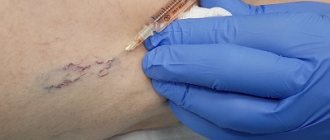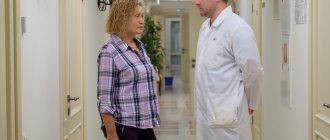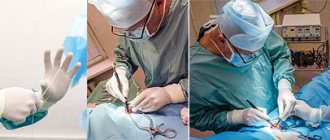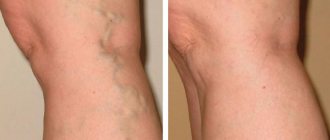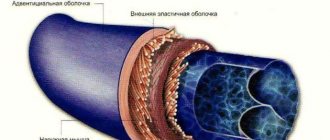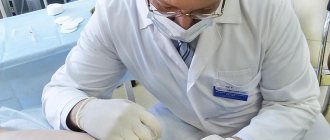Multicolored legs
Thin and thick, red and blue... veins on the legs. Almost every woman studied them, intently examining her legs and wondering what they were? They appear out of the blue, and every year there are more and more of them. Some try not to notice these defects, others begin to worry when they are not even visible to others. However, the fact remains: this problem affects almost every person. Many patients are very surprised when they find out that they have dilated vessels, because this can mean anything: barely visible veins, or unaesthetic varicose veins. In fact, vessels are tubular organs (channels) of various sizes through which blood or lymph moves. In this article we will only touch on blood vessels, which in one way or another appear externally on the skin. On the skin, as a rule, you can see either thin red vessels with a diameter of less than a millimeter (usually capillaries or arterioles), or vessels of blue and purple shades up to several millimeters thick; quite often much larger vessels appear - the so-called varicose veins. If they begin to change and look like ugly subcutaneous nodes and tangles, then you should think about whether varicose veins have “fell” on your poor legs?
"Spider" entangling your legs
Varicose veins are the most common vascular pathology, affecting up to 40% of the working population, it is a manifestation of congenital weakness of the walls and valves of the veins and in most cases is hereditary.
Aggravating factors, in addition to hereditary predisposition, are prolonged sedentary standing, pregnancy, and obesity.
Signs of varicose veins are varied and depend on the form and stage of development of the pathological process. External manifestations may include tortuous and dilated subcutaneous venous trunks and their tributaries, swelling of the feet and legs, darkening and thickening of the skin in the ankle area, fragility of blood vessels and a tendency to hemorrhage, trophic ulcers and bleeding from varicose nodes.
The main complaints with varicose veins include a feeling of fatigue and heaviness in the legs, cramps of the calf muscles at night, dull arching pain and swelling, which intensifies with a prolonged vertical position.
Varicose veins.
Menopause
Climax
2503 March 23
IMPORTANT!
The information in this section cannot be used for self-diagnosis and self-treatment.
In case of pain or other exacerbation of the disease, diagnostic tests should be prescribed only by the attending physician. To make a diagnosis and properly prescribe treatment, you should contact your doctor. Varicose veins of the lower extremities: causes, symptoms, diagnosis and treatment methods.
Directly varicose veins without chronic venous insufficiency is a chronic disease with varicose veins of the saphenous veins of the lower extremities without the phenomena of chronic venous insufficiency (edema, hyperpigmentation, venous eczema, lipodermatosclerosis, trophic ulcers).
According to statistics, about 30% of middle-aged and older people have varicose veins of the lower extremities.
Often the early stages of varicose veins are missed because the ability to work is not yet impaired and the person is only concerned about a cosmetic defect.
Later stages of chronic venous disease significantly reduce quality of life and require long-term treatment.
Causes
There is no exact answer to the question of the reasons for the development of varicose veins, but it has been established that hereditary predisposition plays a significant role. Scientists have identified gene sections that are responsible for changes in the structure of the venous wall.
The development of the disease is based on a violation of the venous outflow in the lower extremities. With healthy hemodynamics, blood moves from the legs to the heart due to the pumping (pulling) function of the heart, contraction of the muscles of the lower extremities and venous valves.
An important mechanism for the development of varicose veins is disruption of the valvular apparatus of the veins.
In this case, a reverse discharge of blood occurs under the influence of gravity down the venous bed, or venous reflux. Gradually, blood stagnation occurs, causing expansion of the saphenous veins.
Classification
Doctors use the CEAP classification of chronic venous diseases. Each letter in the abbreviation indicates a specific section of the classification.
The letter “C” codes for the clinical class of the disease.
- C0 – there are no manifestations of the disease.
- C1 – the appearance of telangiectasia and reticular varicose veins (reticular veins are medium-sized vessels, larger than capillaries). Telangiectasia is an expansion of venules that are located deep in the skin, and reticular varicose veins are an expansion of veins up to 3 mm in diameter.
- C2 – varicose veins of the saphenous veins more than 3 mm.
- C3 – the appearance of edema of the lower limb.
- C4a – the above symptoms are accompanied by trophic changes in the skin in the form of hyperpigmentation (darkening of the skin area) and/or varicose eczema (damaged areas of the skin with blisters and weeping).
- C4b – lipodermatosclerosis (varicose dermatitis) – excessive skin thickening and/or white skin atrophy (formation of small white scars).
- C5 – healed trophic (venous) ulcer.
- C6 – open (active) venous ulcer.
The letter “E” in the classification stands for etiology, or cause of the disease.
- Ec is a congenital disease.
- Ep – primary disease.
- Es – secondary varicose veins as a consequence of another pathology, for example, due to occlusion by a venous thrombus or due to trauma.
- En – the cause of varicose veins has not been established.
The next letter “A” indicates the anatomical localization of the pathological process.
- As – superficial veins are affected.
- Ap – perforating veins connecting the superficial and deep veins of the lower extremities are affected.
- Ad – deep veins of the lower extremities are affected.
- An – changes in the venous system cannot be detected.
The letter “P” denotes the pathophysiological section of the classification, which reflects the characteristics of hemodynamic disorders in the veins of the lower extremities.
- Pr – reflux.
- Po – occlusion, or blockage of the lumen of a vessel.
- Pr, o – a combination of reflux and occlusion.
- Pn – it is not possible to detect changes in the venous system.
Symptoms of varicose veins
One of the first symptoms that attracts attention is the expansion of small veins and venules in the form of stars (telangiectasia and reticular varicose veins).
Then, a feeling of tightness and squeezing appears in the legs, itching and burning in the legs and ankles, as well as dryness and flaking of the skin of the legs often occur.
These symptoms are caused by gradually developing stagnation of blood, lack of oxygen in the tissues, as well as a delay in the removal of metabolic products from the tissues.
A common symptom of varicose veins is swelling: marks from shoes and elastic socks remain on the skin. With a progressive deterioration in blood outflow, throbbing or aching pain, muscle spasms appear, and leg cramps may occur at night.
In advanced cases, in addition to the indicated symptoms, the color (pigmentation) of the skin in the area of the legs and ankles changes to brownish.
Sometimes local redness of the skin develops and the risk of developing trophic ulcers in this area increases.
A trophic ulcer is an extreme degree of skin malnutrition and often occurs as a complication of varicose veins. The term “trophic” indicates that the ulcer arose as a result of tissue malnutrition and in the affected area the ability to heal independently is sharply reduced. This is why trophic ulcers are extremely difficult to treat, and chronic infection in this area can lead to the development of dermatitis and eczema. In severe cases, the purulent process can spread deep into the tissues, affecting the subcutaneous tissue and muscles.
Trophic ulcers occur in chronic venous insufficiency.
Diagnostics
Primary diagnosis of varicose veins of the lower extremities is primarily based on the patient’s typical complaints and external manifestations:
- Heaviness in the legs;
- Rapid fatigue of the legs;
- The appearance of edema;
- Itching, burning, numbness, cramps;
- Enlarged veins visible to the naked eye (“stars”, varicose veins, swollen veins on the legs);
- Changes in skin color and structure;
- Long-healing ulcers.
The diagnosis is confirmed using instrumental examination methods and excluding other causes of dilated veins.
- Ultrasound of the veins of the lower extremities (Doppler);
Let's run to the doctor!
Unfortunately, many patients with dilated veins in the legs are in no hurry to see a doctor, since “protruding nodes”, apart from a cosmetic defect, do not cause them any suffering. But this is a misconception!
Varicose veins is a disease that sometimes leads to very serious complications - deep vein thrombosis, thrombophlebitis, trophic ulcers, since it disrupts the outflow of blood from the lower extremities. Venous congestion in the legs leads to blood thickening and blockage of blood vessels with a blood clot. As a result of impaired venous circulation in the legs, the nutrition of the skin deteriorates, and long-term non-healing trophic ulcers form.
Veins on the legs protrude: treatment
Treatment of this pathology can be conservative or include surgery. Sometimes two types of treatment are combined to achieve maximum effect, reduce inflammation and pain, speed up blood circulation and valve function.
Treatment of vein pathology with drugs
Treatment with medications involves the use of anticoagulants (if complications develop - thrombosis) and venotonics. Also, while taking medications, it is imperative to adjust your diet and start doing therapeutic exercises. As an additional preventative measure, all kinds of compresses for the legs, cool showers, compression garments and cream are prescribed.
Expert opinion
Also, along with drug therapy, surgical treatment of veins is used. In the first stages, laser treatment is effective, in which the laser is applied to the inner wall of the varicose vein. The wall is heated under the influence of the beam, and the patient does not feel severe pain. Thanks to laser treatment, bulging veins in the legs of men and women disappear within a few months.
Vascular surgeon, phlebologist
Osipova Ekaterina Yakovlevna
In addition, radiofrequency ablation (Ablatio) is used in surgical treatment. With this method, body tissues are exposed to radio frequency frequencies. The varicose vein is punctured and a waveguide pre-connected to a radio frequency generator is inserted into it. On the computer, doctors see the temperature in the vessel. Using the device, the venous walls are heated to reduce the lumen. In this case, the device affects only the walls of blood vessels, but it can only be used on large vessels.
Another common method of treating varicose veins is sclerotherapy. It is classified as a chemical method. A special medicine is injected into the enlarged lumen of the vein, which promotes its narrowing and gluing. The method is suitable for small veins, but for large veins it is not effective enough.
Let's join hands, friends.
If you find dilated venous nodules, you need to be examined by a phlebologist. A visual examination by a doctor is usually supplemented by the necessary examination - ultrasound duplex angioscanning, based on the results of which the phlebologist will give you the correct diagnosis and will be able to determine further treatment tactics.
Unfortunately, neither drug therapy, nor wearing elastic bandages or compression garments, nor physical therapy can lead to a cure, but only to a temporary slowdown in the progression of the disease, because It is impossible to eliminate the causes of its occurrence in a conservative way. However, conservative measures are indicated and effective in preventing complications when radical treatment is not possible.
Glue or cut?
Vein sclerotherapy
- Cost: 6,500 rub.
- Duration: 20-60 minutes
- Hospitalization: No hospitalization required
More details
The pages of modern magazines are full of advertisements about the non-surgical treatment of varicose veins, the so-called “sclerotherapy”. However, unfortunately, only rare forms of this pathology are eliminated non-surgically. Surgery remains the radical method. Sclerotherapy (introduction of “gluing” substances into dilated veins) only complements, but does not replace the treatment of varicose veins.
Fear of pain and large postoperative scars sometimes makes patients refuse surgery. Of course, surgery is a certain risk, but the risk of complications if you refuse surgery is much higher. There is an opinion that surgery does not lead to a lasting positive result, and varicose veins reappear even after it is performed. This is not entirely true. The further course of the disease depends on the type of structure of the venous system. There is a group of patients who, after surgery, “forget” about their veins. Another notices the appearance of new dilated ducts. There is no need to be afraid of this. Regular visits to a phlebologist will allow you to get rid of these troubles. And in this case, sclerotherapy takes a leading place.
A phlebologist will put you back on your feet
In recent years, phlebology has been developing rapidly - new minimally invasive technologies are being introduced that make it possible to obtain a high cosmetic effect, make the operation less painful, without at the same time reducing its effectiveness.
The consultative and diagnostic department of CELT employs highly qualified phlebologists who use the most advanced technologies in their work. An individual type of treatment is selected for each patient, involving a combination of various techniques. It is possible to choose a method of pain relief from various types - local anesthesia to general anesthesia. Gentle methods of treatment involve rapid restoration of working capacity, and in a number of cases, there is no need at all to change the usual lifestyle during the treatment period. Our Center provides treatment for both primary varicose veins of the lower extremities and for relapses of the disease after previous surgery or sclerotherapy. However, we must remember that at the slightest manifestation of varicose veins (and this could be the appearance of “vascular networks” or simply an increase in the venous pattern on the legs), you should immediately consult a doctor, since in the initial stages the treatment is most effective, including from an aesthetic point of view .
Causes of varicose veins
Experts identify several common causes of varicose veins:
- Hereditary predisposition is often transmitted through the female line - in 75% of cases in patients with varicose veins, relatives (grandmothers, mothers) encountered the same problem. At the same time, varicose veins of the legs in women are not inherited, but congenital pathologies of the structure of the veins are observed (weakness of the vascular walls, inferior valves, etc.).
- Often the cause of varicose veins in women is associated with an unbalanced rhythm of life. Constantly wearing high heels, sedentary work, lack of physical activity, or overloading the legs due to prolonged standing leads to a decrease in vascular tone and blood stagnation in the veins. To compensate for this imbalance, the veins dilate, while women still experience swelling and a feeling of heaviness.
- Hormonal imbalance can also contribute to the development of varicose veins in women. This may be due to hormonal fluctuations from one menstrual cycle to another, the use of oral contraception, etc.
- The appearance of varicose veins may be associated with pregnancy and labor. At this time, the constantly growing child compresses the veins of the pelvis, plus the amount of blood and hormones in the woman’s body increases. Under the influence of such factors, the ligaments of the women’s pelvis become more elastic, and the extensibility of the veins and their walls increases.
If a woman has problems with her veins before pregnancy, this can ultimately affect her course. Pregnant women with varicose veins are at risk of bleeding after childbirth, untimely discharge of amniotic fluid, and weak labor. Therefore, in case of any pathologies of the veins or in the presence of a hereditary predisposition during pregnancy, it is necessary to be observed by a phlebologist.
So that the blood runs through the veins...
Finally, we would like to offer you some useful tips:
- Don't sit cross-legged;
- When sitting for a long time, for example at a table, place your feet on a small bench;
- When resting at night or during the day, place a pillow under your feet so that your feet and legs are slightly above heart level;
- When traveling by car, it is advisable to stop every 1.5–2 hours, get out of the car, do several squats and walk around for 10–15 minutes;
- If there is a high probability of illness, do not take hot baths, do not visit the bathhouse or sauna;
- Avoid overheating your feet and sunburn;
- Do not wear tight shoes or tight clothing.
What is the prevention of varicose veins?
Preventive measures in the fight against varicose veins have 2 goals.
Firstly, it is to prevent the development of the disease in women who have a predisposition to it. If there is at least one risk factor for the appearance of varicose veins, then there is no need to wait for the appearance of ugly clusters on the legs, unpleasant symptoms, and even more so complications, if all this can be prevented.
Secondly, in the case of existing varicose veins, prevention will help avoid progression of the disease and the development of complications.
In any of the two cases, preventive measures involve eliminating risk factors for the development of varicose veins and minimizing them, which can only be achieved by changing several aspects of life:
- First of all, it is necessary to reduce weight to normal through dietary correction and exercise. When playing sports, it is better to give preference to exercising on exercise machines in a lying or reclining position. Such training practically does not put long-term stress on the superficial veins of the legs, but at the same time strengthens the muscles and improves blood circulation.
- Avoid prolonged stress on the legs - sitting, standing, lifting heavy objects. If such a regime is due to the peculiarities of a woman’s work, then it is worth taking breaks as often as possible, doing special gymnastics, going up and down the stairs on foot.
- When resting or sleeping, you need to keep your legs 15 cm higher than your heart level. Just use small pads or cushions to achieve this position.
- Review your wardrobe. He should not wear clothing that restricts movement in the hips and shoulders, and shoes with heels higher than 4 cm or with flat soles. This does not mean that a woman should completely give up tight clothes and beautiful high-heeled shoes - just choose more comfortable clothes for everyday wear, and leave the rest for special occasions.
- Fans of exotic tanning should avoid regular visits to the solarium and prolonged exposure to the sun.
- Foot care is also important in the prevention of varicose veins. A cool shower with an emphasis on the legs and a nightly massage of the legs and feet are helpful. In addition, you can use special massage baths and small massagers, cooling gels for the feet.
- A good prevention of varicose veins is elastic compression - special stockings, tights and knee socks. Under the influence of compression hosiery, the speed of blood flow increases, and venous congestion disappears. The selection of knitwear must be carried out in strict accordance with special tables by a phlebologist.
